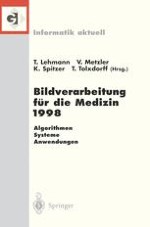1998 | OriginalPaper | Buchkapitel
Colored 3D-CT Reconstruction
A Planning Tool in Skull Base Surgery
verfasst von : Erck Elolf, Marcos Tatagiba, Madjid Samii
Erschienen in: Bildverarbeitung für die Medizin 1998
Verlag: Springer Berlin Heidelberg
Enthalten in: Professional Book Archive
Aktivieren Sie unsere intelligente Suche, um passende Fachinhalte oder Patente zu finden.
Wählen Sie Textabschnitte aus um mit Künstlicher Intelligenz passenden Patente zu finden. powered by
Markieren Sie Textabschnitte, um KI-gestützt weitere passende Inhalte zu finden. powered by
Introduction: Planning of skull base surgery involves a large number of conventional pictures. Three-dimensional CT-reconstruction added a different perspective in demonstrating spatial relationships of bone, tumor and vessel in a single illustration. Methods: 70 patients with skull base lesions (63 neoplastic and 7 vascular) were examined with spiral CT and 3D-reconstruction preoperatively. The reconstruction both visualized the pathology in its relationship to the adjacent bone and vessels -labelled in different colors— and simulated the possible surgical approaches. A General Electric High Speed Advantage CT and a maximum of 95 ml intravenous contrast media were used. A Spiral CT covering the area of interest was performed and transformed to 1 mm slices. Reconstruction was done after transfering the data set to an Advantage Windows Workstation; this required about 3 to 5 minutes. Editing the 3D-reconstruction took between 20 minutes and 1.5 hours (average one (1) hour) depending on the pathology’s complexity. Results: Preoperative 3D-reconstruction of CT-data renders spatial representation of the lesion in relationship to neighboring structures using data usually acquired in preoperative routine. Complex anatomy is visualized with a handful of pictures including cinematografic presentations. Using the reconstructed 3D-computer model it was easily possible to compare different surgical approaches and its specific exposure. The short time necessary for reconstruction allows the application of this method as a routine preoperative procedure for selected skull base pathologies. Computing time of 1.5 hours in complex cases is acceptable due to the information gained with 3D-imaging. Since a preoperative CT in thin slices is mandatory in skull base surgery, no additional costs are caused. Conclusion: 3D-imaging in skull base surgery is a useful tool for visualizing complex anatomy and for finding the most feasible approach. It represents an application of “virtual surgery” in a standard hospital environment. Since CT data is acquired during preoperative routine, no additional examinations become necessary. We recommend this procedure as a routine preoperative procedure for selected skull base lesions.
